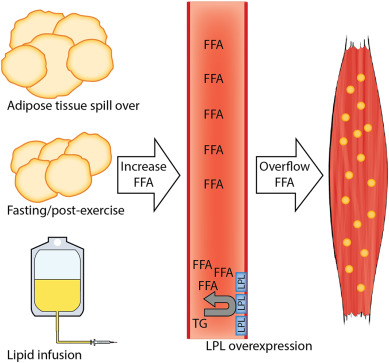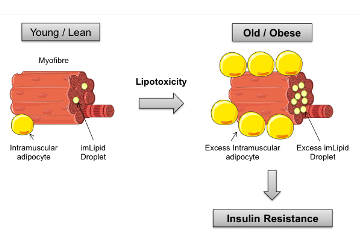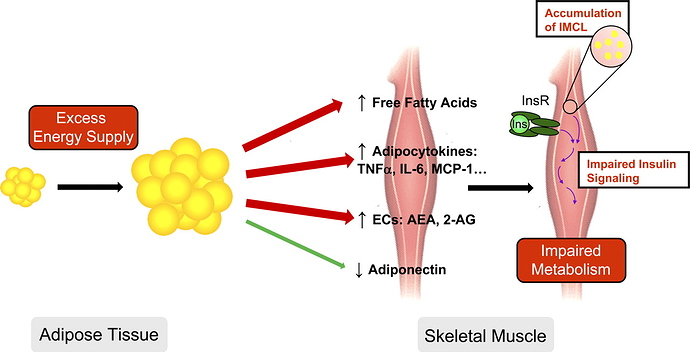This didn’t make sense to me either. Or why not just eat cocoa butter which is higher in stearic acid than even the “stearic enhanced butter” that’s proposed?
Fire in a Bottle - The ROS Theory of Obesity and The Proton Theory
If it were not for Dr. McGuff I would still be lost in Yonkers…lol
As he stated in one of his lectures:
“I want you to take this and run with it”
I’m hopping with it because he is so right and it is so simple and obvious as to the root of all of it?
To respond to various points above -
Both of my tiny brain cells, reading the articles, felt that
a/ I think the reason for the butter oil stuff was because (1) cocoa butter is just not appropriate for 90% of the things we want to eat fat in/on but we do want to ingest the underlying fat and (2) in the end it’s probably cheaper than cocoa butter while also not making our pork chops or stir-fry veggies taste like chocolate. That’s all.
He did, in fact, suggest cocoa butter, in there somewhere (maybe in the comments too).
b/ I know what you mean about the “that’s not a natural %” but it is not impossible (though I’m not claiming it’s so) that our developing ancestors ate mostly sea creatures or large ruminants as dominant diet. The latter are high in stearic acid. The former are high in omega 3. And god only knows what was eaten that doesn’t really exist anymore or it does but it’s really just a very close relative, but might be a little different, and we can only guess today. I think this falls into the same question I used to have about Omega 3s. There are surely lots of humans who ate NOT from the water as their dominant food so how the hell did they get that ideal o3 ratio we keep hearing humans should have?
No matter what though, even if it is not true that “humans should have X% of {omega3, stearic acid, etc.}”, the better question is, “Yes, but if today’s humans, after growing up with these bodies in this environment and food supply, DO get that %, does it improve us, more than doing something else?”
And I think that is what the papers he was referencing seem to indicate, mostly for animals but at least one for humans.
Cheers to the first person who makes a X > Y > Z timeline explaining why I could eat more stearic acid OR do more squats and the results would be the same, because my brain still isn’t getting it 
PS I want to do more squats anyway
PPS Eating cocoa butter is easier 
It all goes over my head for sure. Where my head went was that Dr. Fung’s hormonal model of obesity is predicated to a large extent on inter-cellular signaling, and that Dr. McGuff’s proposition that High Intensity Resistance training like Body by Science, works because it initiates a cascade of intercellular signaling by non-hormonal cytokines called myokines by causing significant muscle damage, high metabolic stress, and high central nervous system stress. That’s what sprung to mind when @atomicspacebunny proposed the booty-centric fat burn model. 
Don Q’s Theory of Myokine Signaling Initiated, Stearic Acid Facilitated Accelerated Lipolysis:
You need to do both. First do squats or other high intensity (greater than 60% 1 rep max) exercise that has a big impact on the central nervous system, causes metabolic stress (lactic acid etc), and causes extensive muscle micro-tearing. This sets of a myokine cascade the lights the wick. Then eat stearic acid. The stearic acid does something wonky and your belly fat burns off like greek fire. The end.
That’s about as far as I’ve gotten. 
+1 on being curious how stearic acid % ties in. I like croissants.
Some illustrations for reference points:
Here you can see how FFA’s spill over into the muscle tissue (ectopic fat).
Where it states young/lean that is how they can eat vast amounts of carbs and not gain a pound is because they are oxidizing not storing carbohydrates. That is amazing!
image link
This is, incidentally, being tested and discussed in another thread:
Thanks Bob, I watched the Eades presentation. I barely stayed awake through it because the whole biochemistry stuff fries my brain, hence my not reading Peter’s site anymore for the same reason. He did finally get to the point though so that was good.
I have to say that I think the Fire in a Bottle site does a tremendously good job (and comparatively to Eades) in describing this for the simple layman like me.
It would be nice if he’d put all those posts and diagrams into one document though. I might capture them to PDF and do that just for simplicity of reference.
Thank you Jordan! I actually thought I’d seen it somewhere but searching did not find it for me so I posted something new.
Very interesting N=1 trying to test that Sat Fat causes weight loss
I took biochemistry in college (my first iteration of college), but that was 45 years ago so I often remember simple things like words and have no idea what they mean.
There was a comedian who said if you majored in the arts and you forgot things 10 years later, it was no big deal. But if you majored in science you remembered just enough to screw up for the rest of your life!
Wowza. Thanks for the link to the Dr. Eades lecture above. Just watched it and probably only understood a small fraction of it.
In answer to your question, he does mention stearic acid. The core of his hypothesis is that reverse electron transport is critical to insulin signaling, and that the necessary F/N ratio for optimal reverse electron transport is .48. If you get below that it doesn’t happen efficiently. Stearic acid has a F/N ratio of .49, which is better than everything else except palmitic acid which is .48 exactly.
I know, I still can’t believe it!
One day they will figure it out, but we probably have a 40 year wall of medical politics to burrow through before it is accepted as fact (universally).
I’m just happy to know ahead of time because I now know how to reverse it. (without starving myself to death)
I don’t like sitting there worried to death about every little carb I eat and blowing up like a ballon if I go one carb over…lol
I think what makes this ROS theory of Obesity so confusing is the use of the phrase “insulin resistance”. After all, how can insulin resistance be both the cause of type 2 diabetes and a possible treatment (in the case of eating saturated fat vs. polyunsaturated fats). It would be helpful to make a distinction between these two kinds of insulin resistance…maybe, as I think Brad Marshall puts it, we can say short term insulin resistance while saturated fat is being oxidized vs chronic insulin resistance. So basically, short term physiological insulin resistance vs chronic insulin resistance.
If we think about what we know from Jason Fung, etc., what I’m now referring to as chronic insulin resistance is caused by prolonged or repeated exposure to too much insulin. This is like if you are taking a drug consistently for an extended period of time. Your body will become tolerant to it and it will not work as well. Tolerance would be another word for resistance in this case. So someone who is insulin resistance has built up a tolerance to too much insulin and their cells’ response to it is down-regulated. I think this is kind of common knowledge here, but I needed to reiterate…
So what are the causes of the body’s overproduction of insulin leading to insulin resistance? The low carb philosophy would say that carbohydrates are the main factor in this because they stimulate insulin the most. Therefore, repeated over-consumption of carbohydrates would cause you to become resistant to insulin, but guess what else spikes insulin? Omega-6 fats spike insulin, especially in combination with glucose!
Here’s my opinion on how this relates to the ROS theory of Obesity: Because long chain saturated fats make your cells insulin resistant, those cells are not using as much insulin, which means there is less demand for insulin production, which means less chronic insulin resistance. I propose that this selective insulin resistance in response to saturated fats is what our bodies are meant to do. As hunter gathers, humans would have eaten high amounts of saturated fat because those are the fats that can be preserved the longest without refrigeration. We would have favored those fats so our bodies adapted to processing them.
Since Omega-6 polyunsaturated fats have not been present in high amounts in our diet until recently, our bodies have not adapted as well to dealing with them. Because of this whole complicated electron transport thingy, the omega-6 fats are not only going to be taken into cells that will try to use them as energy, but they will also not make that cell insulin resistant, so insulin will allow glucose into the cell to join the party with the polyunsaturated fat. The cell doesn’t know what to do, and in its confusion, it poops the fat out wherever is closest. Perhaps into the gluteus maximus  Or, as I think the ROS theory of Obesity is saying, the cells that would first try to use the polyunsaturated fats from our diet would be the ones closest to the our digestive system, (so the cells around your belly). I think that in switching to a diet high in long chain saturated fats you aren’t activating some magical belly fat switch, you are just processing fat the way we are adapted to process it. As far as adding different forms of stearic acid, whether they are cocoa butter, tallow, etc., even if you are eating a form of stearic acid that may not be similar to how our ancestors would have eaten it, it still might be chemically close enough to the saturated fats that we adapted to eat, or at least closer to them than the abundance of high omega-6 fats in so many people’s diets.
Or, as I think the ROS theory of Obesity is saying, the cells that would first try to use the polyunsaturated fats from our diet would be the ones closest to the our digestive system, (so the cells around your belly). I think that in switching to a diet high in long chain saturated fats you aren’t activating some magical belly fat switch, you are just processing fat the way we are adapted to process it. As far as adding different forms of stearic acid, whether they are cocoa butter, tallow, etc., even if you are eating a form of stearic acid that may not be similar to how our ancestors would have eaten it, it still might be chemically close enough to the saturated fats that we adapted to eat, or at least closer to them than the abundance of high omega-6 fats in so many people’s diets.
Sounds reasonable to me.
The way I thought of it (not like I know anything mind you) is that he was talking about essentially a signalling molecule that individual adipose cells have, and would normally use, in SFA>ROS – giving them the “flexibility” to be IR – and to varying degrees, not just off/on – as needed. As opposed to having no choice but to have yet-more fat stuffed into them constantly by insulin whether it would normally be appropriate or not.
I think that is not the same at all as whole-body insulin resistance, spawning from the massive overkill of insulinemia finally filling nearly all the cells up to their genetically-controlled-max.
The guy ate only croissants for two weeks, started feeling full and his appetite dropped. I don’t think there’s anybody here that can eat only croissants for two weeks without dreading the thought of the next meal.
His weight loss can be attributed entirely on a caloric deficit, due to a spontaneous drop in appetite on account of his bland diet, no mystery here.
The problem with anecdotes is that people are terrible at isolating variables and at estimating calories eaten or burned or at measuring anything really.
I’ve also taken a look at his arguments and all of it is based on studies on mice that don’t seem to support his own conclusions.
I’d note his croissants weren’t JUST croissants. He explicitly mentions making pizza croissants with marina, mozzarella and pepperoni. Monotonous, possibly, but it’s not bland in the sense that Guyenet et all use the term.
Yes, if you actually read the article (and know enough), he was taking a swipe at Guyenet et al., who believe we get fat because food simply tastes too good. I.e., don’t add butter to those vegetables, because then you’ll overeat, because they taste too good. Seriously. Really. I’m not kidding, this is an actual Tweet from the Master himself.
Anyway, after testing this by using cocoa butter and now a combination of cocoa butter, butter, and shea butter (latter supposedly highest in stearic acid), I’m convinced. I get so freaking FULL to to point I either cannot or do not want to eat.
And I’ve been low carb/keto 6 years. It’s a revelation! I ate my first meal of the day (lunch?) with cocoa butter and was NOT HUNGRY at all, so I did not eat again until the next day. This has NEVER happened to me, in the 6 years I’ve been doing this. When I tried to eat OMAD, I had to power through the hunger. With cocoa butter, I am not hungry. At all. Could not eat if you paid me.
Also, Peter has updated his blog with calculations:
And someone in the comments posted a spreadsheet so you could see the highest value.
I did not do croissants, as I don’t like wheat. But I’m thinking of trying to make croissants with cocoa butter, butter, and Einkorn wheat (unhybridized) for my kids.
This just shows what the demonization of saturated fat has caused us. This might be – I believe likely is – yet another cause of obesity.
Huh. I don’t interpret this as you do @fabia
I don’t think he is that… novice about the topic. He is both a scientist and a rancher, he’s aware of things like calories. It’s not like he’s just a simple guy who came up with some wild hair and can’t be trusted to be able to multiply by 9 or something. The theories are not his originally, they’re from HyperLipid, and were compelling prior to him ever trying to make it comprehensible to laymen (well… apparently not! lol!) and bringing it into one (of many possible) eating approaches.
- it was only a ‘base’ made (without sugar) and he used it more like a flatbread to hold things for pizza, sandwiches, etc.
- he pointedly was working to make sure his approach could not be attributed to qty of calories, carbs, etc.
- his approach has a growing crowdsource number of people following it that appear to be doing ok with it
The research studies that Peter – and then later in the Fireinabottle blog, Brad – reference seem pretty relevant to me, though I’m no expert. And to them. And to others, like Dr. Michael Eades who gave a presentation on this in 2018 and credited Peter at Hyperlipid for corresponding with him about the theory.
Also, (1) there were a couple studies on humans suggestive to relating to this {not about the ROS process but about obesity and its possible correlation to fat types} and (2) the whole idea of a “new theory” is that there probably is NOT yet much if any research into it, because it’s new.
This leaves people in the world online who are interested in nutrition, new ideas, and self-experimentation, with a road to travel for trying something out, and they can report back on the web about the results… genuine crowdsourcing.
That has pretty much been the case for nearly everything beyond the basics that Atkins then Eades published. We’re all working through the options… if we wait for someone to have done all the science, well, that’s a bit slower than the “proactive self-experiment on behalf of personal optimal health or health results” than most people (certainly me) hope for.







